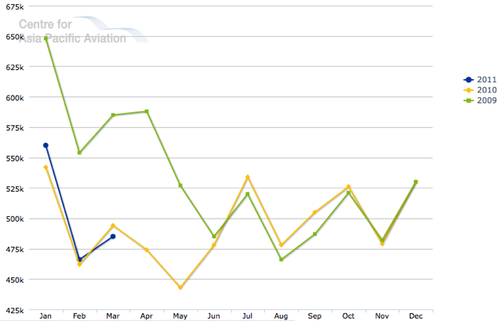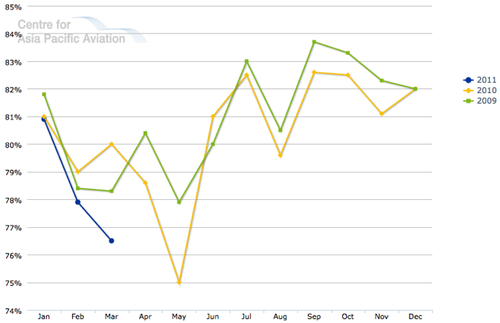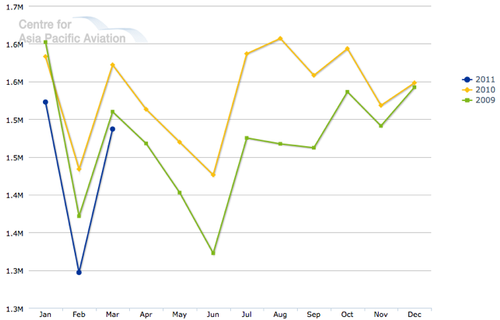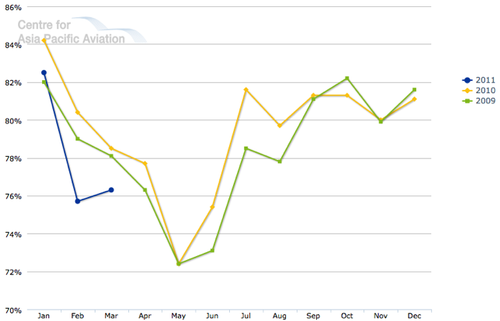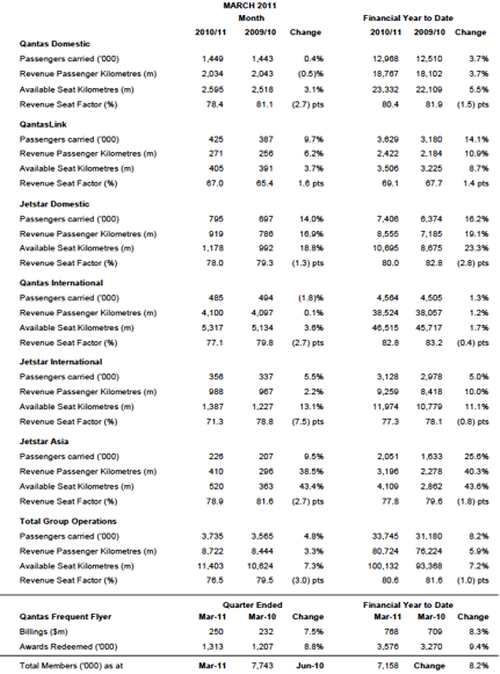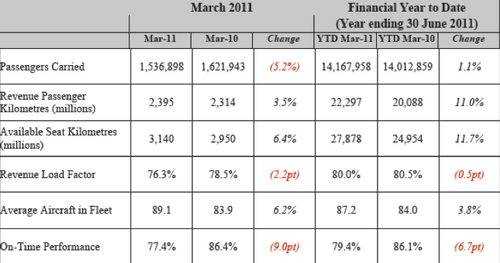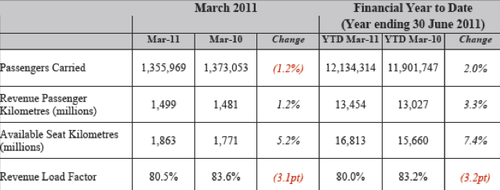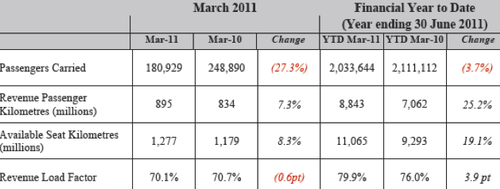Jetstar boosts Qantas Group traffic in Mar-2011; weaker load factors for Qantas and Virgin
Qantas Group and Virgin Blue Holdings reported weakened load factors in Mar-2011, as capacity growth exceeded traffic growth at both airlines. Qantas Group reported stronger passenger numbers in the month, driven by growth at its Jetstar operations, with only Qantas international reporting passenger declines in the month. Virgin Blue, now Virgin Australia, on the other hand reported a reduction in total passengers, as has been the trend over recent months, with reductions domestically and in its smaller international operations.
Jetstar handles 37% of Qantas Group passengers
Qantas Group reported a 4.8% increase in passenger numbers in Mar-2011 to 3.7 million, of which Jetstar-branded operations handled 37% of the total. Jetstar domestic handled 795,000 passengers, a 14.0% year-on-year increase, with passenger growth of 9.5% at Jetstar Asia and 5.5% at Jetstar International. Qantas domestic remained the largest segment of the carrier's operations by passenger numbers with 1.4 million passengers (+0.4%) in the month.
Qantas International witnessed a decline in passenger numbers of 1.8% to 485,000 passengers, to be the only segment within the carrier to see passenger declines in the month. Qantas International passenger numbers are now considerably below 2009 levels, a trend that will continue as the carrier utilises its Jetstar brands to increasingly operate leisure-focussed international routes.
Qantas Airways Passenger Numbers (Qantas, International) (2009 to 2011)
Group traffic (RPKs) increased 3.3%, outpaced by a 7.3% increase in capacity (ASKs) resulting in a 3.0ppt load factor decline to 76.5%. Load factor reductions were witnessed across all the carrier's airline brands, with the exception of QantasLink, which reported a 1.6ppt load factor improvement to 67.0%. The strongest load factors were reported by Jetstar Asia (78.9%), Qantas domestic (78.4%) and Jetstar domestic (89.0%). Group load factors have also been weaker in both Feb-2011 and Jan-2011. They were unchanged in Dec-2010 but weaker in the five months between Jul-2010 and Nov-2010.
Qantas Airways Passenger Load Factor (2009 to 2011)
Single-digit year-to-date yield improvements
Total Domestic (Qantas, QantasLink and Jetstar Domestic operations) yield excluding foreign exchange for the financial year to Mar-2011 increased 0.7% year-on-year. Total International (Qantas and Jetstar International operations) yield excluding foreign exchange in the nine-month period increased 9.3% year-on-year. Domestic and international yields and loads have been impacted by a number of significant weather events, natural disasters and disruptions to the A380 fleet.
Meanwhile, Qantas Frequent Flyer (QFF) billings for 1Q2011 increased 7.5% year-on-year. Over 500,000 members have joined the QFF programme since Jun-2010. Awards redeemed by members increased by 8.8% year-on-year.
Qantas 96% hedged for remaining financial year to Jun-2011
Qantas has hedged 96% of its remaining fuel requirement in 2010/11, at a worst-case crude oil price of USD103.35 per barrel including option premium. Qantas has hedged 44% of its fuel requirement in 2011/12 at a worst-case crude oil price of USD111.20 per barrel including option premium. The carrier has hedged 100% of its remaining operational foreign exchange exposure in 2010/11 at a worst case AUD/USD equivalent exchange rate of 0.8560 inclusive of option premium.
On 19-Apr-2011, Qantas announced increases to international fuel surcharges as a further response to continuing rises in oil and jet fuel prices. Qantas also announced it would increase domestic, regional and Tasman fares by 5% and a fuel surcharge would be added to domestic and Tasman Qantas Frequent Flyer Classic Award redemption seats.
Virgin Blue passenger numbers and load factors weaken
Virgin Blue, now rebranded as Virgin Australia, reported a 5.2% reduction in network passengers to 1.5 million. Passenger numbers in every month so far in 2011 have been below both 2010 and 2009 levels. Domestic operations handled 1.4 million passengers, a 1.2% year-on-year decline with international passenger numbers slumped 27.3% to a considerably-smaller 180,929 passengers.
Virgin Australia Passenger Numbers (2009 to 2011)
The passenger reductions occurred despite a 3.5% increase in group traffic (RPKs), which was outpaced by a 5.4% increase in capacity (ASKs). This resulted in a 2.2ppt load factor reduction to 76.3%. Domestic load factors weakened 3.1ppts to 80.5% and international load factors slipped 0.6ppts to 70.1%.
Virgin Australia Passenger Load Factor (2009 to 2011)
APPENDIX: Qantas Airways and Virgin Blue Mar-2011 traffic highlights
Qantas Airways Ltd traffic highlights: Mar-2011
Virgin Blue Holdings Mar-2011 traffic - total network
Virgin Blue Holdings Mar-2011 traffic - domestic
Virgin Blue Holdings - international
